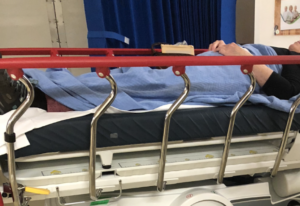A scathing report on conditions in the emergency department of University Hospital Kerry has been published by the Health Information Quality Authority following a two-day inspection.
They found the facility to be grossly overcrowded at 12 noon on the first day with 11 additional patients on trolleys located on the main corridor which was a public thoroughfare.
During the assessment, staff encouraged patients to let them know if they felt unwell while waiting to be reviewed but some patients who spoke with inspectors were unhappy with the care received.

While some said they were happy and that staff were doing a good job, despite the circumstances, the majority of patients were frustrated about the lengthy waiting times be triaged by nursing staff, medically reviewed by medical staff or specialist medical teams and waiting for diagnostic tests.
“Patients were upset and frustrated with the undignified nature of being accommodated on trolleys on the public corridor and the impact this had on their privacy and confidentiality,” the HIQA report stated.
The inspection, conducted on September 20-21 last, with the findings published this week passing a judgement of non-compliance, found that while the standard of hygiene in the emergency department was observed to be generally good, patients commented on the how the overall hygiene levels needed to be improved and the number of bathroom facilities was not enough.
Patients in the emergency department who spoke with inspectors did not receive information on the hospital’s complaints process and inspectors did not observe information leaflets about the HSE’s complaints process.
“This is something hospital management should remedy following this inspection,” HIQA said.
On the two days of the assessment, the HIQA team identified concerns around the adequacy arrangements to manage the increase in demand for emergency care.

The inspectors found:
- The majority of attendees (60%) to the department were self-referrals and the department was grossly overcrowded and on track to have a daily attendance of over 100 people, with 53 patients in the department at 12.15pm.
- Over a third (34%) of these patients were being admitted and were awaiting an in-patient bed.
- Eleven patients were accommodated on trolleys on the corridor. The spacing between the trolleys was not one metre, as per national guidance on Covid-19 in place at time of inspection. This posed a cross-infection risk and hindered efforts to maintain a safe environment for patients and staff.
- On day two of inspection, there were 71 patients in the department at 12 noon and 15 (21%) had been admitted but were awaiting a bed.
- Patients experienced long waiting times to be triaged, medically reviewed and assessed.
- This was further compounded by insufficient patient flow within and outside the hospital and surge capacity in the hospital that resulted in the boarding of 18 patients in the emergency department on the first day of inspection and 15 patients on second day.
- While other hospitals had a formalised escalation plan to support effective day-to-day operational functions when experiencing an increase in demand for services, the plan for UHK had not been ratified and implemented at the time of inspection.
- The lack of that plan was a concern, especially within the context of the Covid-19 pandemic, high attendance rates to the hospital’s emergency department and an approaching winter season, which was expected to be characterised by high levels of influenza.
- On the first day of the inspection, the average waiting time from registration to triage was 38 minutes, which falls short of the 15 minutes recommended by the HSE’s emergency medicine programme.
- The waiting time from registration to triage ranged from five minutes to two hours and 23 minutes.
- The time from a decision to admit to the actual admission ranged from 14 hours to 95 hours.
- Overall, while there were arrangements in place at the hospital to manage and oversee the delivery of care in the emergency department, HIQA was not assured that these arrangements were effective in adequately addressing issues evident in the department on the days of inspection.
 KillarneyToday.com: Everyone reads it – ask anyone. Call 087-2229761 to advertise
KillarneyToday.com: Everyone reads it – ask anyone. Call 087-2229761 to advertise

































